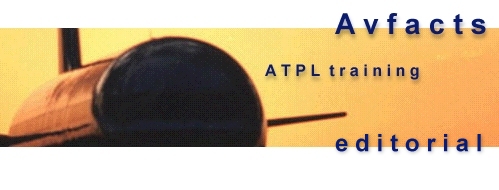This mini-editorial is a minor extract from the ATPL
Aerodynamics and Systems course, run by
Avfacts. It does not cover the topic in itís entirety.
Anti-skid is incorporated to protect the tyres from the
effects of skidding, and to assure maximum
braking is achieved especially when the runway is slippery, and there is
a chance of hydroplaning. The same system is
often fitted to automobiles.
The use of powerful hydraulic braking systems have the
adverse side affect of not allowing the pilot
to appreciate the wheels may be locking up. The anti-skid system will
reduce the braking effort applied to the tyres and allow them to
spin-up again. It recognises any potential
wheel lock-up through wheel speed sensors.
The wheel speeds are sent to an anti-skid computer,
which compares the rate at which the wheel
slows to a computer model of brake performance under perfect conditions.
If the wheels slow too quickly ABS relieves
enough hydraulic pressure to stay within the
model deceleration limits. It must be appreciated that aircraft ABS
systems, unlike some automobiles, do not
"pulse" the brake pedal, or stop and restart wheel rotation.
They simply make possible the maximum deceleration that can be
achieved in the conditions.
Although normally selected ON for dry runway operations,
ABS really comes into itís own if the runway
is contaminated with water, ice, or snow. The antiskid on
one brake unit being
inoperative will mean another 250 metres extra runway required in dry
conditions for the B767, which has 8 main wheels. A wet or
puddled runway will require a good deal more
runway. Total failure of the anti-skid system on the 180, 000 kg B767
will mean a reduction of about 17, 000 kg from the planned
takeoff weight. Failure of the anti-skid
braking system is thankfully quite rare.
It is important for you to understand that the anti-skid
computer will be confused if you release brake
pedal pressure during the landing roll. You should hold a constant pedal
pressure and let the anti-skid do the work of limiting wheel
lockup.
Using Autobrakes (B767)
On approach you have two braking choices
1.
To use manual braking
through the pedal brakes, which applies brakes via the antiskid
modulating valves. Any lockup is detected, and brake pressure
(hydraulic pressure applied to the brakes) is
reduced to allow wheel spin-up, at which point more
braking effort is again applied. This gives maximum deceleration
achievable in the conditions. Maintain steady
brake pressure and let the anti-skid valves do the job. - do
NOT release the brake pedal force, or you will confuse the
antiskid computer.
2.
To select (arm)
Autobrakes on (settings 1, 2, 3, 4, or Max Autobrakes).
The pilot does not apply manual braking at all through the pedals
in this case.- brakes will come on
automatically once the wheels have spun-up after touchdown. In setting
the autobrakes you are scheduling the degree
of deceleration desired (ie: 1 is light braking,
4 is lots). Typically setting 1 or 2 is sufficient (normal).
Autobrakes also work through antiskid
modulating valves, to prevent wheel lock-up. The rate of
deceleration achieved is sensed by the Inertial Nav System (INS/IRS),
and braking effort is trimmed by the autobrake
computer to supply that deceleration rate. If you apply
significant pressure to the brake pedals during the landing roll
with Autobrakes operating, the Autobrakes will
disarm, assuming you wish to take over using
manual (pedal) braking.
Application (contribution) of reverse thrust during
autobrake operation will see the autobrake
wheel braking effort reduce, as the autobrake computer (through sensing
inputs supplied by the INS) attempts to
maintain the desired deceleration rate per second.
Cancelling reverse (typically at about 80 kt) will see the
opposite happen.
You can increase or decrease the autobrake selection at
any time. Eg: if you are using autobrakes
setting 2, and you are running out of runway, you could select autobrake
4. If you are targeting a particular exit
taxiway to leave the runway, and it is a fair
way ahead, then de-schedule the autobrakes
setting to reach the taxiway at the appropriate
speed without first stressing the brakes, and then having to
apply power again to get there.
This editorial is NOT designed to replace company
operating policy. Where any conflict exists,
always use the policy outlined in the approved AFM.
I hope this editorial is beneficial to your
understanding of braking systems. ATPL training
course topics can be found at :
http://www.aviationshop.com.au/avfacts/atp/default.htm
This outlines the topics contained within each of the
online or book based courses that are designed
to meet the Australian ATPL theory training syllabus.
To assist those having difficulty finding suitable
Aerodynamics and Systems texts, limited
edition texts (Aerodynamics & Systems Parts 1, 2, and 3) are now
available at the
online
pilot shop,
and most pilot supply shops around Australia. These are not full
courses, but are designed as focussed ATPL references texts, and
are extremely popular. Full ATPL course
information is available at:
http://www.aviationshop.com.au/avfacts/Courses.htm
and:
http://www.aviationshop.com.au/avfacts/avfacts/atp/default.htm
The full range of ATPL study reference texts are
available at:
http://www.aviationshop.com.au/avfacts/Study_texts.htm
A B737 web site that you may find interesting, can be
found at:
http://www.b737.org.uk
Best regards
Rob Avery
ATPL Lecturer

Marty says ... "Goodbye to GA".










![]()